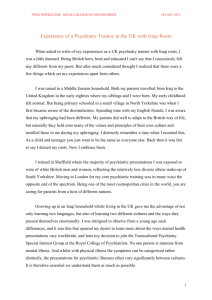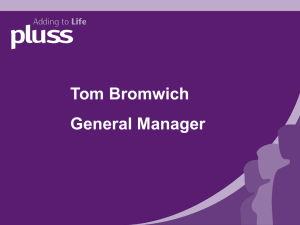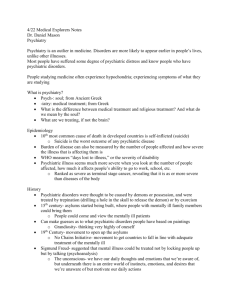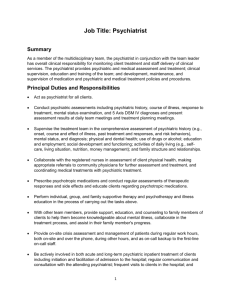Business Case - University of Leeds
advertisement
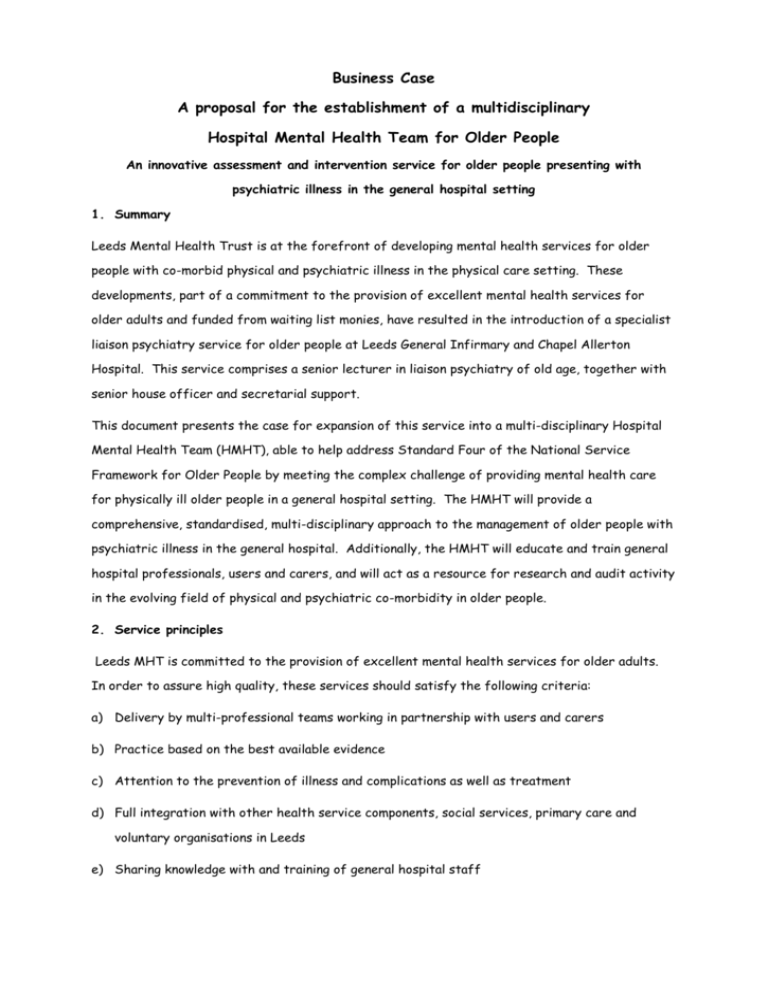
Business Case A proposal for the establishment of a multidisciplinary Hospital Mental Health Team for Older People An innovative assessment and intervention service for older people presenting with psychiatric illness in the general hospital setting 1. Summary Leeds Mental Health Trust is at the forefront of developing mental health services for older people with co-morbid physical and psychiatric illness in the physical care setting. These developments, part of a commitment to the provision of excellent mental health services for older adults and funded from waiting list monies, have resulted in the introduction of a specialist liaison psychiatry service for older people at Leeds General Infirmary and Chapel Allerton Hospital. This service comprises a senior lecturer in liaison psychiatry of old age, together with senior house officer and secretarial support. This document presents the case for expansion of this service into a multi-disciplinary Hospital Mental Health Team (HMHT), able to help address Standard Four of the National Service Framework for Older People by meeting the complex challenge of providing mental health care for physically ill older people in a general hospital setting. The HMHT will provide a comprehensive, standardised, multi-disciplinary approach to the management of older people with psychiatric illness in the general hospital. Additionally, the HMHT will educate and train general hospital professionals, users and carers, and will act as a resource for research and audit activity in the evolving field of physical and psychiatric co-morbidity in older people. 2. Service principles Leeds MHT is committed to the provision of excellent mental health services for older adults. In order to assure high quality, these services should satisfy the following criteria: a) Delivery by multi-professional teams working in partnership with users and carers b) Practice based on the best available evidence c) Attention to the prevention of illness and complications as well as treatment d) Full integration with other health service components, social services, primary care and voluntary organisations in Leeds e) Sharing knowledge with and training of general hospital staff 3. The importance of older people with psychiatric illness in the general hospital Older people already occupy a high percentage of general hospital beds and utilise a high proportion of community resources, and they will continue to do so despite increasing alternatives to acute hospital care, since an ageing population will result in a greater number of older, frailer people who are more difficult to rehabilitate. This is of relevance to those designing mental health services for older people since, in common with other general hospital populations, older people with physical illness have high rates of psychiatric illness. Studies, including some carried out in Leeds, reveal prevalences of up to 40% for dementia, up to 53% for depression and up to 61% for delirium in older people in general hospital wards, rates that are much higher than those found in community settings. Furthermore, the presence of co-morbid psychiatric illness has an adverse impact on several important outcomes, including length of hospital stay, mortality, quality of life, carer strain and institutionalisation. The latter is of particular concern in Leeds, which has high rates of institutionalisation from the general hospital setting. As a consequence of the high prevalence and adverse impact, routine screening for psychiatric illness in older people in general hospitals has been recommended by the Royal Colleges of Physicians and Psychiatrists. Despite being well tolerated, such screening does not often take place, meaning that some psychiatric illness is not recognised. For example, only half of the cases of delirium identified by researchers are recognised by medical or nursing staff. Even when psychiatric illness is identified, little or no further action may be taken. General ward staff may not realise that psychiatric illness is amenable to treatment, and busy ward environments and lack of knowledge about behavioural, psychological, environmental and pharmacological management strategies may result in sub-optimal or inappropriate treatment. This is despite an increasing evidence base for the prevention and treatment of psychiatric illness in this setting. Old age mental health services receive between a quarter and a third of their referrals from general hospital wards, and the number of referrals is rising. These referrals are for advice on diagnosis, investigation, and treatment, assessment of capacity and to arrange follow-up or take over care. The referral source does not always match where the morbidity lies; for example, orthopaedic wards have extremely high levels of psychiatric co-morbidity and yet referrals from these wards are rare. The move of old age mental health services into community bases will have important consequences. First, a rapid response to referrals may be difficult, since practitioners will be HMHT Business Case - John Holmes 2 geographically remote from the general hospital. This may be particularly unhelpful when assessments are required in the accident and emergency department, in order to provide realistic alternatives to admission. Second, the opportunity for frequent reassessment to monitor fluctuating conditions such as delirium or to assess treatment response will be reduced. Third, opportunities for meeting colleagues from other hospital specialities may be reduced, despite the need for closer collaboration between old age psychiatry and medicine for the elderly mentioned in the Audit Commission document “Forget Me Not”. A further problem is that of patients presenting with combined physical and psychiatric nursing care needs, where the presence of severe physical illness precludes them from receiving care in the psychiatric setting, and yet they are too behaviourally disturbed to be adequately cared for by general ward staff. These patients, presenting with complex problems, are not provided for by our current service model; one reason for this is that the routine delivery of mental health care by mental health staff in the general hospital setting is unfortunately rare. 4. Potential options for mental health care in the general hospital setting a) Standard sector model. Here, mental health input is on a reactive, consultation basis, relying on the abilities of general hospital staff to detect and refer psychiatric illness. Assessment is virtually always by psychiatric medical staff, and there is usually little or no review of patients until they are discharged from the general hospital. Although considerable travelling may be required resulting in inefficiency, this model has the advantages of continuity and ease of communication within the community teams, since members of those teams perform the assessments. b) An enhanced sector model. In this model, a community mental health team receives extra staff time (usually nursing staff) in order to provide input to the general hospital. Community staff provide inreach to general hospital wards. The opportunities for non-medical assessments and continuity of care are good, but this is primarily a consultation model and the opportunities for liaison are limited. Again, considerable travelling time may be required. c) The liaison nurse. Here, a psychiatric nurse acts as a filter for referrals received, performs triage and generally asks for a medical psychiatric assessment on a quarter to a third of those cases seen. These posts usually entail a degree of teaching and training of general nurses, but tend to be oriented towards higher-referring wards, especially medicine for older people. There is potential for the introduction of screening programmes with this model. Most services where this model operates have only one nurse in post, and this brings an unrealistically high workload. Community services are provided by a sector team as in a). HMHT Business Case - John Holmes 3 d) Outreach from psychiatric wards. Here, psychiatric ward staff nurses visit general hospital wards to provide advice on behavioural management and other issues. This is usually on a consultation basis, although there is potential for teaching. This model is only realistic when wards are on the same site, and depends on ward staff not being needed on their own ward at the time. Again, community services are provided by a sector team as in a). e) Shared care. In this model, both psychiatric and general nurses and psychiatrists and physicians staff a ward on the general hospital site. This model can cope with the complex care needs presented by co-morbidity, such as the patient who exhibits challenging behaviour due to delirium who needs physical investigation and treatment for the cause of the delirium. There is also the opportunity to care, for example, for people with severe depression and marked physical care needs. This model builds up the clinical skills of all staff working on the shared care ward, and there is the potential for outreach, but the numbers of people with such care needs may not be enough to make a ward viable unless it serves a large population. This model is hospital based, and requires community services to be provided by a sector team. f) A hospital mental health team. Here, psychiatrists, psychiatric nurses, occupational therapists and psychologists work together to deliver mental health care to the general hospital setting. Each practitioner has responsibility for certain areas of the hospital, but can call on the specialist skills of other team members where appropriate. This model operates on a consultation and liaison basis; referrals are both received as usual and sought proactively through the introduction of staff training and supervision to improve the detection and management of psychiatric co-morbidity. Good channels of communication, with rapid electronic, written and telephone contact, ensure that community teams and services are kept informed where community follow up is needed, and allow community staff to easily request assessments for people on their caseload who are admitted to the general hospital. The HMHT can be thought of as operating like a community mental health team, but with the population of the general hospital as its sector population. The model is hospital based, and requires community services to be provided by a sector team, bringing potential for communication difficulties with community services. There is also the potential for lack of continuity of care with this model. 5. Current provision for psychiatric care in the general hospital setting. In Leeds, the Leeds MHT currently provides almost all of the mental health services for older people in the general hospital setting, and there are two contrasting models of care. In the majority of the city, predominantly serving St James’s University Hospital and Seacroft Hospital, there is a standard sector service with five community mental health teams. HMHT Business Case - John Holmes 4 Assessments are almost exclusively medical; although there are some clinical psychology sessions available at St James’s, and managed by Leeds Teaching Hospitals Trust, these are not coordinated with the Leeds MHT services. There are few staff with specialist mental health training in the general hospital setting. Limited outreach is available from psychiatric wards at Seacroft and the Roundhay Wing. The community-based services are unable to respond rapidly to requests for assessments from the accident and emergency department; these are carried out by non-specialist on call junior medical staff. The pressure of community work means that general hospital referrals can be seen as a lower priority, although older people can be equally at risk in hospital as at home, and older people in general hospitals should have the same access to a rapid, specialist psychiatric assessment as those at home. There is limited opportunity for regular review after assessments, and little opportunity for involvement in staff training. Two Leeds PCG areas, the West and North West, incorporating three old age psychiatry sectors, are provided with a specialist liaison psychiatry service for older people at Leeds General Infirmary and Chapel Allerton Hospital. This service has assessed and treated over 1600 older people. Initial staffing is a half time senior lecturer/honorary consultant and half time senior house officer, together with secretarial support. With this, the service is able to respond significantly faster than the community teams and currently reviews about a half of the referred patients whilst they remain in the general hospital. There is an influence on general hospital staff practice, as a consequence of which the referral profile has altered, and the service has also become more proactive, rather than working to the reactive consultation model. Good channels of communication mean that community teams are kept informed, and a case register has been constructed to enable the prospective collection of high quality data on case-mix, diagnoses and follow-up plans for clinical, audit and research purposes. A specialist out-patient clinic has been established. This liaison psychiatry service for older people was the first of its kind in the UK, although several other places now have similar sevices. 6. Proposed service model From the options laid out in section 4, option f - a specialist, multidisciplinary, Hospital Mental Health Team – is the option proposed by this document. The HMHT will be based in the acute hospital setting and will directly serve older people who are inpatients at Leeds General Infirmary or Chapel Allerton Hospital. The team will provide advice on detection, diagnosis and management of psychiatric illness presenting in this setting, and will also provide education and support for non-mental health trained general hospital staff, aimed at improving their skills of detection of psychiatric illness and its appropriate management. The team will be accessed at HMHT Business Case - John Holmes 5 the tertiary level, through referrals from general hospital staff and from existing sector mental health teams for older people. The new service will work in parallel with existing community mental health teams and intermediate care teams, referring on where community follow up is needed. Team members will supervise non-specialist screening and management of psychiatric illness, carry out protocoldriven specialist assessment and monitoring, and provide a rapid response to requests from all hospital departments, including Accident and Emergency and the Rapid Response Team. The HMHT will complement and enhance the current service model by providing an innovative solution to the problem of physical and psychiatric co-morbidity. It will enhance the mental health care skills of general hospital staff, leading to improved detection and management of psychiatric co-morbidity in the physical setting to an extent that a traditional, consultationbased sector service model is unable to do. It will be able to focus specialist mental health care on the more complex problems. This will have several benefits in terms of improved outcomes. For example, evidence from the USA suggests that a HMHT can significantly reduce length of hospital stay with a cost benefit, and this would be expected in an NHS setting. Other evidence suggests that advice on suitability of psychotropic medication results in the reduction of adverse events such as falls and therefore improvements in quality of care and quality of life. The focus of the HMHT will be on wards where psychiatric morbidity is high rather than simply on where referrals come from. Clear lines of communication will ensure good links with community services, and a cornerstone of the team will be rapid and accurate assessment and monitoring, with the development of a case register holding diagnostic and other data for clinical, research and audit purposes. Such a framework will allow for the evaluation of the impact of the HMHT on the management of psychiatric illness in the general hospital setting. This evaluation will initially be pragmatic, in the form of quantitative and qualitative before and after studies of outcomes and staff and user/carer opinion of the usefulness of the service. A further important aspect of the evaluation will be descriptive methodology of case-mix and other factors, together with examination and operationalisation of the processes and techniques of the HMHT so that the service can be accurately reproduced and evaluated elsewhere in a trial setting. Training of health care professionals in the complex area of co-morbid physical and psychiatric illness would build upon the city’s strengths in liaison psychiatry services for adults of working age, providing a trans-generational service. The result will be the enhancement of the reputation of Leeds as an innovative mental health care provider, with consequent benefits for staff recruitment and retention. HMHT Business Case - John Holmes 6 The HMHT will operate at the tier four level of mental health services for older people, providing alternatives to psychiatric admission and addressing previously unmet needs in the general hospital setting, including the accident and emergency department. It will integrate with other tiered service developments within Mental Health Services for Older People in Leeds. Although initially building on the success of the current liaison psychiatry service for older people at Leeds General Infirmary and Chapel Allerton Hospital, once the team is proven to be a successful service model there is potential for similar provision to St James’s University Hospital and Seacroft Hospital, and outside Leeds. 7. Objectives of the Hospital Mental Health Team. To complement and enhance existing mental health services for older people. To improve the delivery of mental health care to the general hospital setting with the intention of improving outcomes. To improve the skills of general hospital staff in the detection and management of psychiatric illness in older people in the general hospital setting. To provide a specialist assessment and treatment service for older people with psychiatric co-morbidity in the general hospital setting using a multi-disciplinary team of staff trained in the assessment and management of psychiatric illness presenting in the general hospital. To implement detailed, protocol-driven, multidisciplinary assessments in order to facilitate both the design and delivery of comprehensive care packages both in the general hospital and after discharge to the community, and accurate diagnosis for clinical and research purposes. To provide a mechanism whereby older people with psychiatric illness presenting in the general hospital can be regularly reviewed and the adherence to, and impact of, interventions assessed. To provide an educational resource for the provision of information on the presentation, diagnosis and management of psychiatric co-morbidity to general hospital staff, patients and carers. To provide a resource for the training of health professionals from a variety of backgrounds in the complex area of co-morbid physical and psychiatric illness. To develop a clinical and research facility with national and international repute, combining two research areas, physical and psychiatric co-morbidity and service development, both research priorities of the Academic Unit of Psychiatry and Behavioural Sciences at the University of Leeds. HMHT Business Case - John Holmes 7 To allow for regular and systematic review and audit of the service, with high quality, prospectively accumulated data. HMHT Business Case - John Holmes 8 8. Financial implications The bulk of the financial burden will be in staff costs. These are estimated as follows: Staff description WTE Annual Cost (£) HMHT Practitioner 3 81000 0.6 Already provided through (e.g. G grade nurse, Senior I OT) Consultant Psychiatrist waiting list monies Senior house officer 0.5 Already provided through Leeds MHT Consultant Clinical Psychologist 0.5 31650 1 15000 (mid-point) Team Secretary Total additional staff costs 127650 Other recurrent costs are detailed as follows: Description Cost (£) Service audit and evaluation 10000 Recruitment 5000 Training and personal development 5000 Team accommodation Telephones 2100 Clothing 240 Stationery 500 Furniture and fittings 500 Total other recurrent costs 23340 Total recurrent revenue costs 150990 Other start-up costs are as follows: Description Cost (£) Furniture, fittings, IT equipment HMHT Business Case - John Holmes 5000 9


